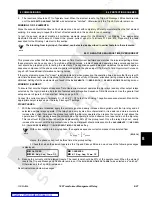
GE Multilin
745 Transformer Management Relay
8-37
8 COMMISSIONING
8.6 AUXILIARY PROTECTION AND MONITORING FUNCTIONS
8
8.6.2 HARMONIC DERATING FUNCTION
Testing of the Harmonic Derating function requires that accurate transformer parameters such as Load Losses at
Rated Load and Winding Resistance be entered. This feature makes use of the Harmonic Derating Factor (HDF)
computed by the relay, using the harmonic content of the current signals and the transformer data (refer to IEEE
C57.110-1986 for the computation method). Once the derating factor falls below a set value, the 745 can trip and/or
alarm.
OPERATING LEVEL:
1.
To verify the correct operation of this element, a current signal containing harmonics must be introduced into one
phase of the relay. Use Figure 8–1: Test Setup on page 8–3 to accomplish this. Set the fundamental component at
rated CT secondary into Winding 1 Phase A. Gradually increase the second harmonic component (and the rest of the
even harmonics) while displaying the
A2 METERING
ÖØ
HARMONIC CONTENT
ÖØ
HARMONIC DERATING
ÖØ
W1(3) HAR-
MONIC DERATING FACTOR
value. The element should operate when the displayed HDF equals the element setting.
2.
Check that the Trip, Pickup (and Alarm if selected) LEDs are on, and one of the following is displayed:
3.
Lower the DC component until the element resets. The reset value should be approximately 2% larger than the oper-
ate value. Verify that the Pickup and Alarm LEDs reset if the target function is set to "Self-resetting". The Trip LED
should remain latched.
OPERATING TIME:
To measure the basic operating time of this element, preset a fundamental and DC component composite current signal to
cause the element to operate. Using the setup of Figure 8–1: Test Setup on page 8–3, apply the current suddenly, at the
same time the timer is triggered. The measured operating time should correspond to the time delay setting for the element.
8.6.3 TRANSFORMER OVERLOAD
The transformer overload element uses the Phase A current of each winding to compute a transformer loading. The
computation assumes a rated voltage on the wInding, hence the loading is effectively a percent of rated load cur-
rent.
OPERATING LEVEL:
1.
Inject a fundamental-frequency current into Phase A of Winding 1. Increase the current signal to a value just above the
Transformer Overload Pickup setting (take into account the CT ratio and the rated-MVA phase current to set the cur-
rent correctly). The element should operate after its set time delay.
2.
Check that the Trip, Pickup (and Alarm if selected) LEDs are on, and one of the following is displayed:
3.
Lower the current until the element resets. The reset value should be approximately 97% of the operate value. Verify
that the Pickup and Alarm LEDs reset if the target function is set to "Self-resetting". The Trip LED should remain
latched.
OPERATING TIME
Using the setup in Figure 8–12: Frequency Element Testing on page 8–29 with the Interval Timer enabled, set the current
level to 1.5 times the operate level of the element and apply suddenly by closing the double pole switch. Record the oper-
ate time and compare to the
S4 ELEMENTS
ÖØ
XFORMER OVERLOAD
ÖØ
TRANSFORMER OVERLOAD DELAY
setting.
The blocking from logic input, if enabled, can be tested as described in earlier tests for other elements.
LATCHED
W1 Harm Derating
OPERATED
W1 Harm Derating
LATCHED
Xformer Overload
OPERATED
Xformer Overload
NOTE
NOTE
NOTE
Содержание TRANSFORMER MANAGEMENT RELAY 745
Страница 2: ...Courtesy of NationalSwitchgear com ...








































